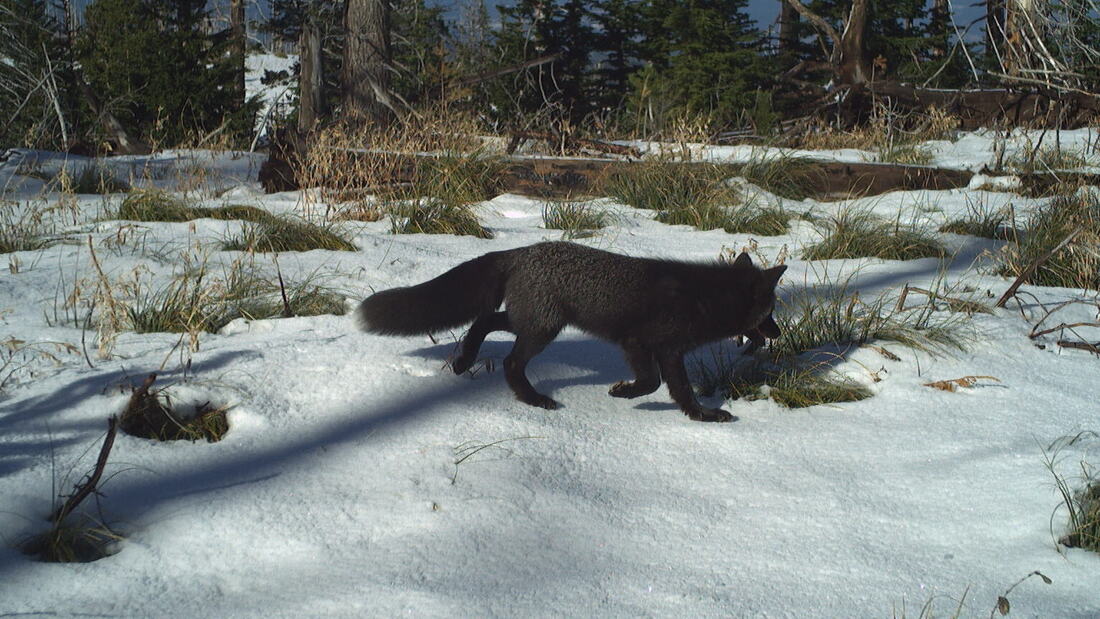Cascadia Wildlife Blog
News from the Wolverine Tracking Project and more
WINTER SEASON Our winter season is in full swing and we have been busy meeting and training our Camera Crew and Tracking Survey volunteers! We have been having fun doing field trainings in local parks and at Mt. Hood, have gone out on our first Group Tracking Survey, and are looking forward to bringing back our first photos for the winter season. CAMERA SURVEY While we don't have winter photos to share quite yet, our last two sets of photos from our summer camera locations were recently retrieved, and we have some amazing detections to share from them! First, check out this canine - it's a red fox! These animals can display a few different coat colors, or "phases." The pictures below are of a silver phase fox. Even though it does not appear red, it is a member of the same red fox species! This is one of the target species of the Wolverine Tracking Project. There are a few subspecies of red fox, one being the Sierra Nevada red fox, which is particularly rare. This subspecies resides at higher elevations than your typical fox, and because we carry out surveys for carnivores at Mt. Hood, this is the perfect area to look for these animals!  A fox crosses through our camera site. For our target species, we especially hope to find scat, urine, or hair samples from these animals which can be used for genetic analysis. Not only does this confirm their presence in our survey areas, but there is a lot to learn from genetics too! Since the Sierra Nevada red fox is a subspecies that is spatially isolated from other populations, we are particularly interested in how the DNA of these animals may differ from other subspecies. Our next detection shows a fox urinating, which would be a perfect genetic sample! Unfortunately, too much snow fell before this camera was visited, so no sample could be collected. We can cross our fingers for another chance as the season goes on! From top to bottom: A fox circles and urinates near some brush. A fox sniffs the ground before leaving the area. Next up, we would like to share some adorable black bear detections from the last of our summer photos. These animals will be hibernating very soon, so we probably will not be seeing them for a while. Female black bears can remain in their dens as late as mid-April and will give birth to cubs while still in the den! These cubs will then remain with their mother for up to two years before heading out on their own. An adult black bear sniffs and rubs on a tree before leaving the view of the camera. We also want to share some photos of very curious cubs! From top to bottom: A black bear cub stands on its hind legs while smelling and rubbing on a tree, then rolls onto the ground. A black bear cub grabs some vegetation while rolling around on the ground. Last from these camera checks, we have a sweet doe visiting our camera in the snow! Like the black bears, deer are quite busy during this time of year. They are coming to the end of their rut, or breeding season. The rut is marked by physiological and behavioral changes, where males shed the velvet on their antlers and begin fighting with other males. By this time of year, most bucks have mated with several does. Come spring, we will be seeing sweet spotted fawns with their mothers! A doe walks through the snow towards the camera, looks to the left, and leaves the site. And with that, we have shared some of the highlights of our last summer photos. We are very excited for our hard-working volunteers to visit our cameras again soon, bringing back the first photos for the winter season. Please check back next month to see more highlights and to learn more about the animals we find!
0 Comments
Leave a Reply. |
Categories
All
Past Posts
May 2024
|
|
|
Copyright © 2021
|